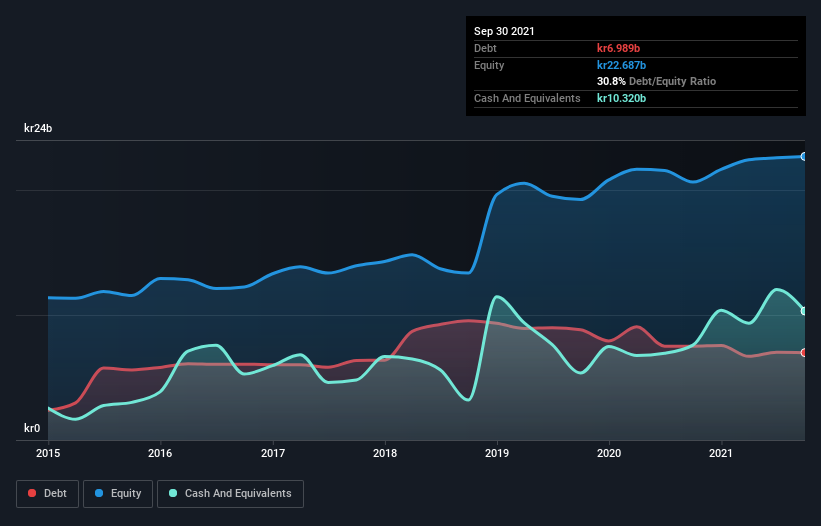- Sweden
- /
- Aerospace & Defense
- /
- OM:SAAB B
These 4 Measures Indicate That Saab (STO:SAAB B) Is Using Debt Safely

Warren Buffett famously said, 'Volatility is far from synonymous with risk.' It's only natural to consider a company's balance sheet when you examine how risky it is, since debt is often involved when a business collapses. We note that Saab AB (publ) (STO:SAAB B) does have debt on its balance sheet. But the real question is whether this debt is making the company risky.
When Is Debt A Problem?
Debt is a tool to help businesses grow, but if a business is incapable of paying off its lenders, then it exists at their mercy. In the worst case scenario, a company can go bankrupt if it cannot pay its creditors. However, a more common (but still painful) scenario is that it has to raise new equity capital at a low price, thus permanently diluting shareholders. Of course, the upside of debt is that it often represents cheap capital, especially when it replaces dilution in a company with the ability to reinvest at high rates of return. The first thing to do when considering how much debt a business uses is to look at its cash and debt together.
See our latest analysis for Saab
What Is Saab's Net Debt?
You can click the graphic below for the historical numbers, but it shows that Saab had kr6.99b of debt in September 2021, down from kr7.51b, one year before. However, it does have kr10.3b in cash offsetting this, leading to net cash of kr3.33b.

A Look At Saab's Liabilities
According to the last reported balance sheet, Saab had liabilities of kr23.8b due within 12 months, and liabilities of kr15.9b due beyond 12 months. On the other hand, it had cash of kr10.3b and kr15.0b worth of receivables due within a year. So it has liabilities totalling kr14.3b more than its cash and near-term receivables, combined.
This deficit isn't so bad because Saab is worth kr32.5b, and thus could probably raise enough capital to shore up its balance sheet, if the need arose. But we definitely want to keep our eyes open to indications that its debt is bringing too much risk. Despite its noteworthy liabilities, Saab boasts net cash, so it's fair to say it does not have a heavy debt load!
On top of that, Saab grew its EBIT by 36% over the last twelve months, and that growth will make it easier to handle its debt. The balance sheet is clearly the area to focus on when you are analysing debt. But it is future earnings, more than anything, that will determine Saab's ability to maintain a healthy balance sheet going forward. So if you want to see what the professionals think, you might find this free report on analyst profit forecasts to be interesting.
But our final consideration is also important, because a company cannot pay debt with paper profits; it needs cold hard cash. Saab may have net cash on the balance sheet, but it is still interesting to look at how well the business converts its earnings before interest and tax (EBIT) to free cash flow, because that will influence both its need for, and its capacity to manage debt. Over the most recent three years, Saab recorded free cash flow worth 80% of its EBIT, which is around normal, given free cash flow excludes interest and tax. This cold hard cash means it can reduce its debt when it wants to.
Summing up
While Saab does have more liabilities than liquid assets, it also has net cash of kr3.33b. And it impressed us with its EBIT growth of 36% over the last year. So we don't think Saab's use of debt is risky. When analysing debt levels, the balance sheet is the obvious place to start. However, not all investment risk resides within the balance sheet - far from it. To that end, you should be aware of the 2 warning signs we've spotted with Saab .
At the end of the day, it's often better to focus on companies that are free from net debt. You can access our special list of such companies (all with a track record of profit growth). It's free.
New: Manage All Your Stock Portfolios in One Place
We've created the ultimate portfolio companion for stock investors, and it's free.
• Connect an unlimited number of Portfolios and see your total in one currency
• Be alerted to new Warning Signs or Risks via email or mobile
• Track the Fair Value of your stocks
This article by Simply Wall St is general in nature. We provide commentary based on historical data and analyst forecasts only using an unbiased methodology and our articles are not intended to be financial advice. It does not constitute a recommendation to buy or sell any stock, and does not take account of your objectives, or your financial situation. We aim to bring you long-term focused analysis driven by fundamental data. Note that our analysis may not factor in the latest price-sensitive company announcements or qualitative material. Simply Wall St has no position in any stocks mentioned.
Have feedback on this article? Concerned about the content? Get in touch with us directly. Alternatively, email editorial-team (at) simplywallst.com.
About OM:SAAB B
Saab
Provides products, services, and solutions for military defense, aviation, and civil security markets Internationally.
Flawless balance sheet with moderate growth potential.
Similar Companies
Market Insights
Community Narratives



